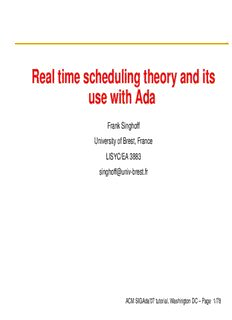Table Of ContentReal Time Scheduling and its use with Ada
Frank Singhoff
To cite this version:
Frank Singhoff. Real Time Scheduling and its use with Ada. Tutorial presented to the annual inter-
national conference of the ACM SIGAda, Nov 2007, United States. pp.x-y. hal-00504347
HAL Id: hal-00504347
https://hal.univ-brest.fr/hal-00504347
Submitted on 20 Jul 2010
HAL is a multi-disciplinary open access L’archive ouverte pluridisciplinaire HAL, est
archive for the deposit and dissemination of sci- destinée au dépôt et à la diffusion de documents
entific research documents, whether they are pub- scientifiques de niveau recherche, publiés ou non,
lished or not. The documents may come from émanant des établissements d’enseignement et de
teaching and research institutions in France or recherche français ou étrangers, des laboratoires
abroad, or from public or private research centers. publics ou privés.
Real time scheduling theory and its
use with Ada
Frank Singhoff
University of Brest, France
LISYC/EA 3883
[email protected]
ACM SIGAda’07 tutorial, Washington DC – Page 1/78
Talk overview
1. Introduction
Real time systems.
What is real time scheduling.
What we aim to do in this tutorial ?
2. Real time scheduling theory
Introducing real time scheduling theory.
Usual real time schedulers.
Few words about shared resources.
Modeling and analysis tools.
3. Ada standards and real time scheduling
Real time scheduling with Ada 1995/2005, Ravenscar.
POSIX 1003 and its Ada binding.
4. Summary and further readings
ACM SIGAda’07 tutorial, Washington DC – Page 2/78
Real time systems
• "Real time systems are defined as those systems in
which the correctness of the system depends not only on
the logical result of computation, but also on the time at
which the results are produced" [STA 88].
• Properties we look for :
Functions must be predictable : the same data input
will produce the same data output.
Timing behavior must be predictable : must meet
temporal constaints (eg. deadline, response time).
Reliability : the system must meet availability
constraints.
=⇒ Predictable means ... we can compute the system
behavior before execution time.
ACM SIGAda’07 tutorial, Washington DC – Page 3/78
What is real time scheduling (1)
• Many real time systems are built with operating
systems providing multitasking facilities, in order to:
Ease the design of complex systems (one function =
one task).
Increase efficiency (I/O operations, multi-processor
architecture).
... but the use of task scheduling implies that task
schedulers must:
Stay predictable.
Take urgency/criticality task contraints into account.
ACM SIGAda’07 tutorial, Washington DC – Page 4/78
What is real time scheduling (1)
• Many real time systems are built with operating
systems providing multitasking facilities, in order to:
Ease the design of complex systems (one function =
one task).
Increase efficiency (I/O operations, multi-processor
architecture).
... but the use of task scheduling implies that task
schedulers must:
Stay predictable.
Take urgency/criticality task contraints into account.
Multitasking makes the predictability analysis difficult to do.
ACM SIGAda’07 tutorial, Washington DC – Page 4/78
What is real time scheduling (2)
• Example of a processor embedded into a car, which
is composed of the following tasks:
1. A task displays every 100 milliseconds the current speed of the car.
2. A task reads a speed sensor every 250 milliseconds.
3. A task runs an engine monitoring program every 500 milliseconds.
=⇒ How can we check that every tasks will meet their timing
requirements ?
=⇒ If the system is complex (eg. large number of tasks), the designer
must be helped to perform such an analysis.
ACM SIGAda’07 tutorial, Washington DC – Page 5/78
What is real time scheduling (3)
• The real time scheduling theory is a framework which
provides :
1. Algorithms to share a processor (or any resource) by
a set of tasks (or any resource users) according to
some timing requirements =⇒ take urgency/criticality of
the tasks into account.
2. Analytical methods, called feasibility tests or
schedulability tests, which allow a system designer to
analyze/"compute" the system behavior before
execution time.
ACM SIGAda’07 tutorial, Washington DC – Page 6/78
What we aim to do in this tutorial
• Real time scheduling theory is born 30 years ago, but
few people use this framework:
1. This theory is sometimes difficult to be applied
(sometimes unsuitable).
2. Few analysis tools exist ...
3. Few software designers know such a theory.
This tutorial presents you:
1. The foundation of the real time scheduling theory.
2. How it can help you to model and to analyze a real time
system (examples of modeling/analysis tools).
3. Ada real time scheduling facilities, if you plan to use real
time scheduling theory.
ACM SIGAda’07 tutorial, Washington DC – Page 7/78
Talk overview
1. Introduction
Real time systems.
What is real time scheduling.
What we aim to do in this tutorial ?
2. Real time scheduling theory
Introducing real time scheduling theory.
Usual real time schedulers.
Few words about shared resources.
Modeling and analysis tools.
3. Ada standards and real time scheduling
Real time scheduling with Ada 1995/2005, Ravenscar.
POSIX 1003 and its Ada binding.
4. Summary and further readings
ACM SIGAda’07 tutorial, Washington DC – Page 8/78
Description:Assuming VxWorks priority levels (high=0 ; low=255). T1 (blue) : C1=6, P1=10, .. ARINC 653 [ARI 97]. ACM SIGAda'07 .. Reference Manual. Language and

